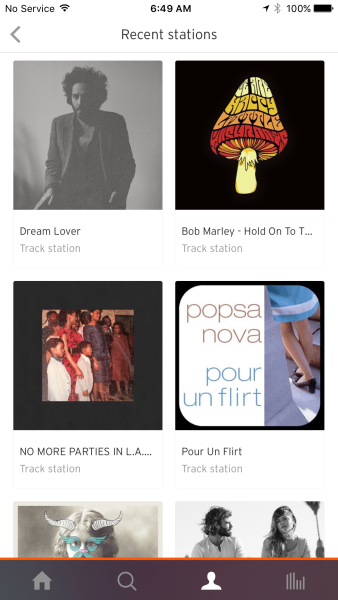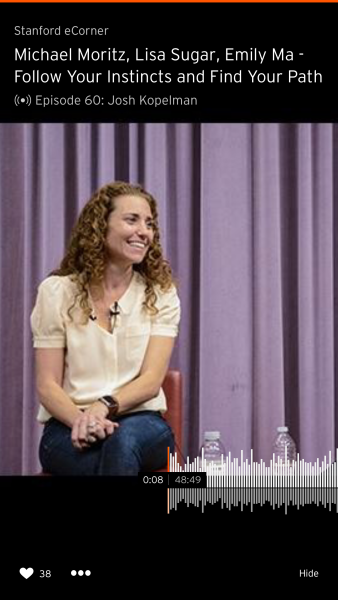Songs That Stayed With Me In 2016
I liked over 450 songs on SoundCloud in 2016. These are the ones that stayed with me.
I liked over 450 songs on SoundCloud in 2016. These are the ones that stayed with me.
My friend Stephen and I have been talking about hacking the Amazon Echo so it can be a front end to our Sonos systems. Stephen decided to make it more than talk and downloaded some code on Github and stitched together a system that works. I was at his house yesterday evening and he showed it to me. Here’s a blurry video taken from a phone that shows it in action.
Stephen’s system uses the cloud based Skills interface to parse the commands, then sends instructions to some of that Github code running on Amazon’s Lamba cloud based code execution service, which then sends instructions to a local server on Stephen’s laptop that runs the code that controls the Sonos locally on his home network. It’s a kludge for sure, but it works and I am going to get this hack working on my Sonos system over the next few weeks.
But the whole experience got me thinking about hacking the Echo to do other things. The possibilities are endless.
Here’s an idea for some enterprising engineer out there. We own some bungalows in Venice that are rented out on Airbnb and VRBO. We have a Sonos Play in each of them. And we have a Google Doc that has frequently asked questions on it hanging in the kitchen of each bungalow. What if there was an app for Amazon Echo that could take in that Google Doc, parse the frequently asked questions and answers, and train Alexa (the voice command interface in Amazon Echo) to answer the frequently asked questions. That would get me to swap out the Sonos Plays in each bungalow for Amazon Echos. And Airbnb could promote that app to all of its hosts.
Anyway, there are all sorts of things that would be fun to make by hacking Echo. And I suspect they will. These voice based devices could be the next big platform for developers to make things on.
I recall reading a history of The Beatles and as it is told, they developed their performance skills playing in rock clubs in Hamburg Germany in the early 60s. They played night after night and developed a style and technique that formed the essence of the band for the next decade.
I thought of that today when I read a NY Times piece on our portfolio company YouNow.
My long time friend Steve Greenberg, a thirty year veteran of the music industry, is quoted in the piece talking about one of his young developing stars who performs on YouNow:
In the old days, an artist would have to find some club to get good about relating to an audience. With YouNow she can just go online and play, whether it’s for hundreds or thousands of people, and get real-time feedback.
What used to require moving to Hamburg and playing clubs every night can now be done in the comfort of a teenager’s bedroom, it seems.
We finally got an Amazon Echo in our home a few weeks ago. We have had one at USV for quite some time and have had fun hacking around on it. But I really wasn’t prepared for what was going to happen when we got one at home.
We have Sonos in our homes. I often joke that I have more Sonos devices than any other person. It may be true.
But since we’ve been able to just call out the music we want to listen to and get it, I have been using the Amazon Echo a lot more and the Sonos a lot less. And we only have Echo in one room whereas we have Sonos throughout our house, connected up through in wall/ceiling speakers. I wrote that convenience trumps quality many years ago, and I am reminded again how true that is.
The other night we were at the dinner table in the kitchen hanging out and chatting after dinner and there was no music on in the kitchen where we have Sonos. I desperately wanted to call out some music but obviously could not. I could have gotten up and gotten my phone and put some music on via the Sonos app. But I didn’t. That got my attention.
We’ve already had this on our phones (Google Now and Siri) but there is something about having this on your home audio system that is really sweet. I suspect many of us will be calling the music we want to hear using voice commands in the coming years.
If you haven’t seen the Amazon Echo playing music, here’s a short video of made of the experience just now.
We lost one of my favorite musical artists this week. We’ve been listening to Prince non-stop for a couple days now to remember him.
I really enjoyed watching the cast of Hamilton celebrate his life and music.
One of the things that many of us dislike about our cable company is the bundle. We are required to subscribe to a host of channels when we only want a few. The promise of going over the top is that we can now choose the services we want without the ones we don’t.
But we are now witnessing the re-emergence of the entertainment bundle in the over the top world.
The leader in the new bundle movement is Amazon which is putting entertainment options into its Prime service. Estimates for Prime membership go as high as 60mm households. We are one of them and have been for as long as Prime has existed.
The other bundler is YouTube. Their newish Red subscription service offers ad-free youtube, “original shows”, and premium music.
I expect Prime and Red to expand over time to include additional services (games, sports, etc). They are the new entertainment bundlers. I also expect others to enter this business. The most obvious candidates are the mobile carriers who already have a regular billing relationship with us.
The good news is that the new bundlers do not have a monopoly in their ability to offer entertainment to us. They have to compete with each other in an open market. So I expect that the bundles that emerge will be attractively priced and will be differentiated by price and content options.
Bundling has cost advantages like sales and marketing that can be offset across multiple services. And it is easier to subscribe to one service than ten. But over the top promises user choice over our entertainment options. With the new bundlers, we may be getting the best of both worlds.
Our portfolio company SoundCloud quietly launched something this past week that has quickly become my go to music discovery experience. It is called “track stations” and the concept is not new but they have applied it a bit differently. Like Pandora, you can enter a song you like and get a radio like listening experience.
The difference is that SoundCloud has something like 110 million tracks in it versus something like 2 million tracks in Pandora. That’s important because it means that there are way more tracks to start stations with but even more importantly, the track stations give you access to a long tail of content that you can’t really access any other way. Using algorithms and data science to take you from the head of the curve content to the long tail is an interesting idea across many content categories, but it is particularly interesting in music and podcasting.
I started a track station one morning this past week in my car and within 30 minutes, I had added five or six tracks to my favorites. And I didn’t know any of the artists who made any of the tracks I favorited.
It works like this. You open the SoundCloud app on iOS or Android and search for a track you know and like:

Then you click on the track to start playing it:

On the lower left are three dots. If you click them, you get:

And if you click on “start a track station”, you get:

If you go to your collections in the app, you will see all the track stations you listen to regularly:

But here’s where it gets really interesting. You can use the same technique to find new podcasts to listen to. If you start a track station with a podcast you like, like this one:

You can swipe through to find similar podcasts like these:



So that’s it. If you have SoundCloud on your iPhone or Android, find a track you like and start a track station. It’s a great way to find new things to listen to.
Right now, track stations is only available on SoundCloud’s mobile apps. It will be coming to their web app and other apps soon.
We are enjoying the entire Beatles catalog streaming via Sonos in our vacation house this morning. That’s because the Beatles finally decided to put their music on the various streaming services and their catalog arrived today.
The Beatles did not put their music on iTunes until 2010. So it is not surprising that they took such a long time to join the streaming music world.
It is worth noting a few things.
First, you don’t need the Beatles to build a great streaming product. They are a nice to have but not a need to have. It seems that there are no “need to haves” in the world of streaming music as long as you have most of the artists. No one artist is that powerful, even the greatest artist of the pop music era.
Staying off iTunes until 2010 and streaming until 2015 may have made good business sense for the Beatles, but it was certainly not a fan friendly move. It took me all of one minute to load up their entire catalog into our Sonos queue and hit play. That is such a superior experience to loading CDs, one by one, into a CD player, or downloading each and every record from iTunes and then creating a playlist. I am not sure where the line should be drawn by an artist between maximizing profits and maximizing the fan experience. But I don’t think the Beatles drew that line correctly over the past fifteen years.
The Beatles’ music is timeless. Unlike most pop music, the Beatles’s music seems to appeal to generation after generation. We have several generations in our house this morning and everyone is totally enjoying the music.
So I’m so happy that the Beatles finally decided to join the streaming party and we are celebrating that move. But I sure wish they hadn’t taken so long.
Our portfolio company YouNow is a broadcasting app that tends to be used by entertainers, youtubers, and young people in general. While not as well known as Periscope, it’s users are super into it and highly engaged. This week came the story that a singer/songwriter in the UK named Emma McGann got a song in the top 20 pop charts by regularly performing it on YouNow.
Here’s a short video that tells the story:
My partner Andy got me interested in the livecoding phenomenon. As I’ve been checking it out, I came across this video. Pretty cool.